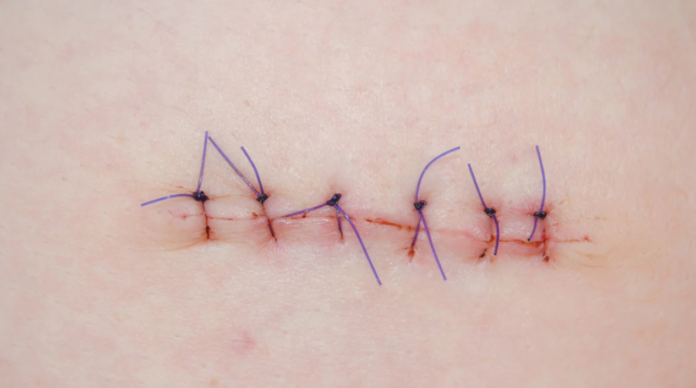Sutures, also known as stitches, are special surgical threads for repairing cuts and closing incisions. Alternative treatments may be needed for some wounds, such as metal staples instead of sutures. Everything depends on the injury.
Your doctor uses sutures to close wounds. The process involves a needle attached to a thread length to stitch the wound shut. Doctors can suture with a variety of materials, as different materials are needed to treat different injuries.
Sutures can either be absorbable or non-absorbable. Absorbable sutures usually do not require your doctor to remove them because enzymes in your body’s tissues naturally digest them.
On the other hand, non-absorbable sutures will need to be removed by your doctor later or, in some cases, left permanently.
How to Care for Absorbable Stitches?
- Clean from the center outward: Cleaning your incision from the “dirtiest” to the “cleanest” section is the best method. Typically, this implies that you should begin in the center of the incision and work your way out. You need to check for any indications of infection, such as pus, oozing, swelling, redness, pain, or persistent inflammation, and follow any specific instructions your doctor gives you.
- Leave scabs alone: Do not brush your sutures’ scabs away if they have any. Scabs are common, and, despite being bothersome, they are a sign that your skin is recovering.
- Be gentle: Never scrub the area around your incision because it might irritate the mending skin. Additionally, it can hinder the healing of your wound. Just like you would any other part of your body, wash your incision in the shower with a little pressure. It would be best to clean your incision with mild soap and water.
- Avoid creams and ointments: As your doctor directs, avoid applying creams or lotions to your wound.
- Avoid soaking: After receiving your stitches, you should wait 12 to 24 hours before taking a shower. It is advisable to take showers instead of baths and avoid swimming. You will receive instructions from your doctor on how to bathe while wearing stitches.
When Should You Consult a Doctor Following Suture Removal?
First, you should ask your doctor about the type of stitches you have been given and how long they should take to dissolve because the time it takes for dissolvable or absorbable stitches to disappear can vary. Most types should start to dissolve or fall out within a week, although it may be a few weeks before they disappear completely, while others may last for several months.
You should consult your doctor to replace the stitches if your wound is infected or if the stitches pop, break, or come loose. If your injury has healed and your stitches are still intact, you should meet with your doctor or practice nurse, who can remove them, rather than wait for them to dissolve completely.
What are the major complications in Absorbable Sutures?
- Infection: If the wound is not properly taken care of, it could lead to an infection.
- Reopening of the wound: The wound may reopen if the sutures are taken out too soon or if pressure is put on the affected area.
- Swollen glands can occur if there is an untreated infection around the sutures. You must see your doctor immediately to treat the issue and replace the stitches.
Why would a person’s body reject absorbable stitches?
- Over-tightening sutures: Most surgical skills and suturing courses emphasize the importance of not suturing wounds under tension. Excessive pressure may cause the suture to break and cut tissue, leading to the wound opening. Practice in avoiding too much tension leads to the successful use of finer gauge materials.
- Absorbable sutures rely on the tissue’s reaction to dissolve quickly. Suture hypersensitivity develops at the end of the absorption process and is correlated with the length of suture absorption.
- The body recognizes a material, determines it to be an irritation or a threat, and responds to it. This is similar to how allergies work: This usually occurs when a foreign object is in the wound. These items could be shards of bone, hair, fabric, etc. External objects may cause issues, including bleeding, inflammation, infection, and severe discomfort, if the doctors don’t discover them during the initial assessment and the wound has been closed.
Thinking about getting absorbable stitches?
The main benefit of absorbable stitches is that the body breaks them down over time, which makes these sutures perfect for covering surgical sites, particularly tissue inside the body that is difficult to access following surgery.
If your doctor has covered your sutures with a surgical dressing, you should follow their recommendations for how frequently to change the dressing. On a hot day, you might need to change your dressing more frequently if you sweat more.
Additionally, if you have itches, treating the itch rather than removing the stitches will give your wound the time it needs to heal fully and enable your absorbable sutures to function.








![Avast Driver Updater Key 2022 | Activation Key V2.5.9 [Free]- Avast Driver Updater Key 2021](https://vintank.com/wp-content/uploads/2021/02/Avast-Driver-Updater-Key-2021-100x70.jpg)
![Avast Premier Activation Code and License Key [Working] Avast Premier Activation Code and License Key](https://vintank.com/wp-content/uploads/2021/09/Avast-Premier-Activation-Code-and-License-Key-100x70.jpg)
